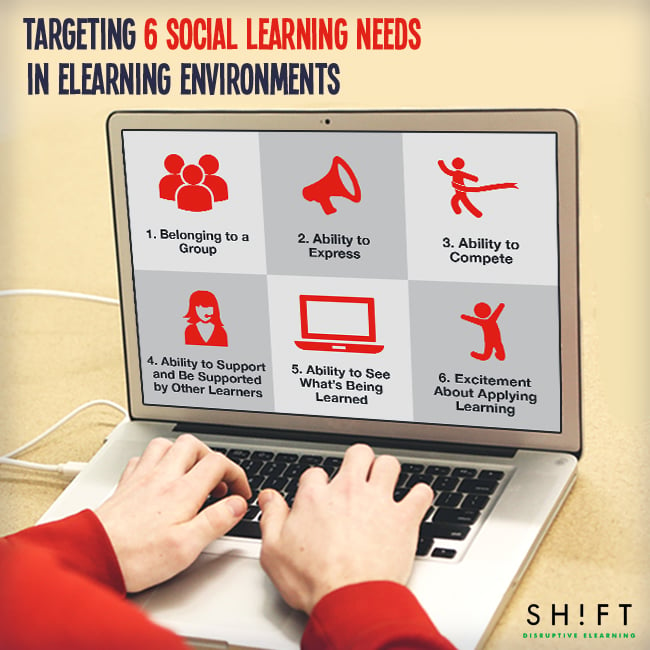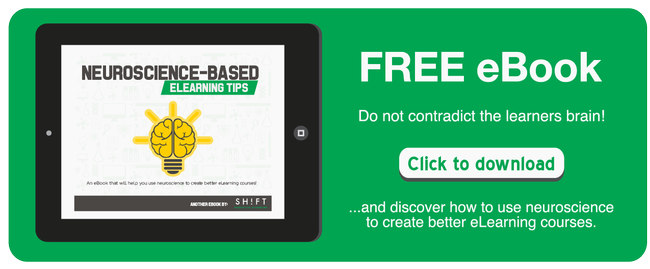It’s time to enable the social learning mode!
When it comes to successful eLearning design, everybody should agree that there’s no such thing as too much information about how the human brain operates. It’s wired for social learning. Our respective environments actually shape our brains and the rest of our bodies.
An interesting three-minute video by Paul Burow discusses the application of neuroscience to organizational development. It covers six social learning needs we think can be applied to eLearning. Targeting these needs will result in more effective eLearning courses.

1. Belonging to a Group
All of us need to feel part of a group, part of something more important and certainly bigger than ourselves. When we don’t perceive our standing in the group, we use a ton of thinking capacity in attempts to fit in.
Because of the social nature of human beings, we learn better in social settings – particularly those involving technology – than without them. When eLearners learn with one or more other people, at least three things occur:
- The individuals are able to work together.
- They compete with one another and in the process, try to do better.
- They might work on their own, but they share goals.
A welcoming environment always helps people enter a new group. Your task in delivering an effective course includes creating a welcoming setting that embraces social presence. You can accomplish that by allowing eLearners to express themselves without risk, fostering collaboration, drawing in learners, generally practicing supportive interactions and establishing an instructor/facilitator presence. The key to effective eLearning design is including options to accommodate both students who work best together and those who learn optimally as individuals.
2. Ability to Express
Technology offers many opportunities to express what learners are feeling and experiencing via blogs, chat rooms, forums and other media. Use a mix of these tools to present the expectation of critical and analytical thought and to foster opportunities for it to occur.
How? Set up specific ways in which your eLearners can both express and defend their ideas, conclusions and opinions so that learning will keep growing within a social environment. Here are some examples:
- Virtual classrooms and video conferencing: Google+ Hangouts, GoToMeeting, Skype or Adobe Connect
- Online discussions: Twitter, Basecamp, Yammer or Google+ Private Communities
- Blogs: These complementary but important writing tools foster a student-centered learning environment for social learning.
3. Ability to Compete
Human beings love to compete and win, particularly at games. One way to foster social learning in eLearning design is to utilize gamification (adding game-like elements to a non-game practice). Also, introducing features of competition to a course – both for teams and individual learners – and online rewards, learners will be much more motivated to pay attention and internalize the learning. If your target learners are in the corporate world, this can skyrocket level of engagement and the number of times each learner makes an attempt.
One helpful technique to bolster peer collaboration is posting questions before every exercise to measure understanding of the content, then providing results in a comparison chart. You can also foster competition by:
- Including metrics easy to compare, like how long it takes to complete an activity
- Creating benchmarks to beat, such as bronze, silver and gold medals or categories.
- Including a place where an eLearner can see personal achievements
- Adding a timer
4. Ability to Support and Be Supported by Other Learners
An eLearner needs to feel truly being supported. This involves trusting that when one member of a group understands a concept that others don’t, that individual can explain it, and vice versa. Your goal is fostering this interaction and creating a social learning environment with:
- Instructional content and learning materials
- Peers
- Instructor
- Overall learning environment
The opportunity for group collaboration and feedback is essential in eLearning environments. Consider techniques like personal responses using email or chat, reflective answers to set questions and shared online comments in blogs and forums.
Truth is, eLearning instructors need to spend more time supporting and encouraging corporate learners than they would in a traditional face-to-face session.
5. Ability to See What’s Being Learned
Learners need to see what they’re learning. For abstract or very complex topics, focus on 5-10 minute sound bites. Learners need to be able to strip away the trappings and leave with the essentials. Your content needs to be relevant, useful, practical, comprehensive. succinct, organized and engaging.
Examples of helpful visual resources include:
- Videos and animation
- Infographics
- Charts, diagrams and graphs
- Relatable content with real-world examples
6. Excitement About Applying Learning
When you’ve accomplished the first five ways to meet social learning needs, the byproduct is excitement about applying learning in the real world every day.
Wanting students to integrate their lessons into their personal lives sounds like a lofty idea. This, however, is the point of training. Don’t be content with using animation, games and multimedia for the sake of including them. These tools only have a temporary effect on a student’s motivation.
As an eLearning professional, you are in a unique position to facilitate learning transfer by:
- Encouraging learners to see how they can use the course materials in a real-world context
- Be sure to include plenty of practice into your eLearning courses—practices makes perfect!
- Incorporating a variety of real-world scenarios and examples in eLearning design
Remember, it’s not about what people know—it's about what they can do with what they know!



